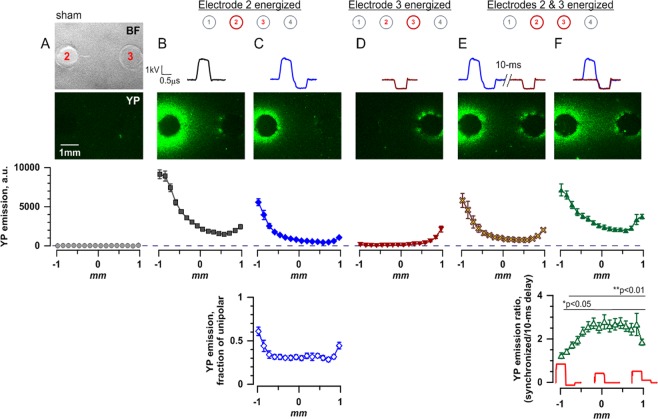Figure 4.
Enhancement of stimulation away from electrodes by the abolition of bipolar cancellation. Stimulation effect was quantified by the uptake of YO-PRO-1 dye (YP) by electropermeabilized cells embedded in agarose gel. Panels (A–F) correspond to different stimulation conditions. For (B–F), we delivered 100 stimuli at 10 Hz; the legend at the top shows the electrode(s) energized and the shape of the pulse. In (A), stimulating electrodes were brought into position but no pulses were applied (“sham exposure”); the top panel shows instead the gel imprints of the electrodes 2 and 3 (see Fig. 2 for the linear array configuration). Areas beyond this region are not considered here (see text and Fig. S1). All YP fluorescence images cover the same area as in the bright field image in panel (A). Below these images, fluorescence intensity measured in 16 regions of interest along the line between the electrodes 2 and 3 is plotted against the distance from the center of the gap between them (mean ± S.E., n = 5). For all exposures, dye uptake is higher near the energized electrode(s) where the electric field is the highest. Note the reduction of effect in panel (C) vs (B), when an opposite polarity phase is added to the unipolar pulse. This bipolar cancellation is quantified as a reduction of emission compared to the unipolar pulse (C, bottom graph), which was significant at p < 0.01 or better for all datapoints (one sample t-test, for the ratio being different from 1). In panels (E,F), we combine the same pulses which were tested separately in panels (C,D). When the pulses are delivered with a 10-ms interval (E) which prevents superposition and pulse shape change, their combined effect is essentially additive. However, when the same two pulses overlap (F) so that the opposite polarity phase is reduced or fully compensated, bipolar cancellation gets reduced and the effect increases up to 3-fold (panel (F), bottom; the inset illustrates some of the pulse shapes formed by the overlap of delivered pulses). *p < 0.5, **p < 0.01, one sample t-test.

